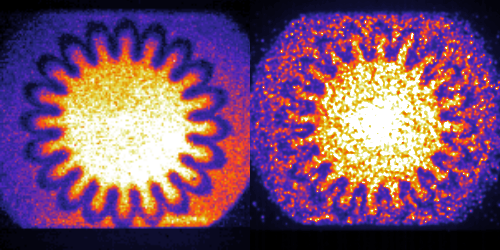Laser-Driven Implosions Similar at Dissimilar Scales
Before CGI, action film makers relied on the principle of scale invariance: a miniature set shot in slow motion looks about the same as a full-sized set shot at regular speed. Now, Joshua Sauppe at Los Alamos National Laboratory, New Mexico, and colleagues have shown that the same principle applies to the hydrodynamics induced in fuel targets by laser-driven inertial confinement. In experiments using two separate laser systems—the National Ignition Facility (NIF) at Lawrence Livermore National Laboratory, California, and the smaller OMEGA laser facility at the University of Rochester, New York—the team reproduced nearly identical hydrodynamic behavior in the fuel, even though the setups operate at very different spatial and temporal scales.
In inertial confinement fusion, a several-nanosecond pulse from a laser array is delivered to a millimeter-scale fuel capsule, imploding the capsule and compressing the fusion fuel within. Sauppe and his colleagues focused on a part of the process called the deceleration phase, when the capsule’s lower-density, fuel-filled core begins to slow the inward motion of its higher-density shell. Hydrodynamic instabilities set up by the density contrast between the shell and the core can cause the materials to mix, cooling the fuel and inhibiting fusion.
The team created cylindrical targets to directly measure instability growth in the deceleration phase. The NIF target had 3 times the radius of the OMEGA one and took 3 times longer to implode. But both experiments exhibited the same scale-invariant hydrodynamics—the first observation of scale invariance in the high-energy-density regime. The result means that researchers can now begin to systematically investigate the effects of physical processes that are not scale invariant, like radiation transport and thermal conduction, which will inform the design of future experiments.
This research is published in Physical Review Letters.
–Marric Stephens
Marric Stephens is a Corresponding Editor for Physics based in Bristol, UK.




